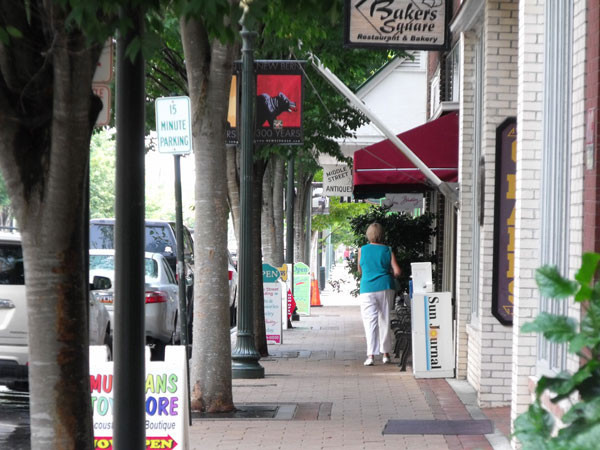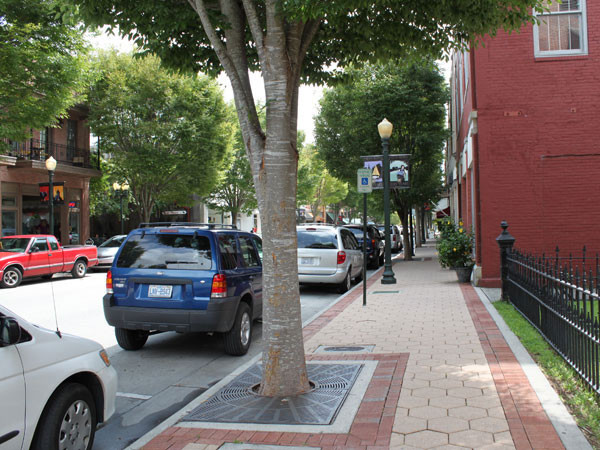Middle Street in New Bern, North Carolina, is more than just a road; it’s a vibrant tapestry woven from history, community, and revitalization. From its picturesque waterfront access to its stunningly preserved architecture, Middle Street perfectly encapsulates the unique spirit of New Bern. This thoroughfare is a living testament to the town’s rich past, spanning colonial times, the Civil War era, and the burgeoning 20th century. Along Middle Street, beautifully restored homes stand proudly alongside five historic churches, the early 20th-century Blades Mansion, and a bustling commercial district, all within a stone’s throw of the Trent River. More than just a scenic route, Middle Street serves as a cornerstone in New Bern’s ongoing efforts to revitalize its economy, skillfully leveraging its historical significance and prime waterfront location.
 Brick-textured sidewalks, 19th-century style lampposts, benches, festive banners and mature trees add to the pedestrian experience of Middle Street.
Brick-textured sidewalks, 19th-century style lampposts, benches, festive banners and mature trees add to the pedestrian experience of Middle Street.
Middle Street’s pedestrian-friendly design, featuring brick sidewalks and period lighting, enhances the visitor experience in New Bern’s historic district.
A Testament to Urban Revitalization
The story of Middle Street is also a story of successful urban revitalization. Like many downtown areas, New Bern faced challenges in the mid-20th century due to urban renewal impacts and the shift of businesses to suburban malls. However, New Bern proactively responded by adopting the Central Business District Plan in 1977. This plan marked the initial step in a concerted effort to breathe new life into the downtown core. Strategically positioned due to its central location, historical importance, and proximity to the waterfront, Middle Street became the focal point of this revitalization strategy. The goal was to transition New Bern’s economic foundation from traditional industries like lumber and agriculture towards tourism and recreation, capitalizing on its inherent assets. Since the implementation of this visionary plan, over $100 million has been injected into downtown New Bern, fueling storefront restorations, strategic infill construction projects, and the creation of inviting pocket parks. Further solidifying this commitment, the city implemented its 1990 Urban Design Plan, which introduced enhanced street amenities such as distinctive pavers, comfortable benches, pedestrian-friendly features, and period-appropriate street lighting, significantly improving the Middle Street experience.
Adding to Middle Street’s allure is the RiverWalk, a continuous 1.5-mile pedestrian promenade that gracefully traces the Trent and Neuse riverfronts. This scenic pathway dramatically improves accessibility to Middle Street, making it even more attractive to both visitors and residents alike. Seamlessly connecting with Middle Street’s southern end, the RiverWalk is nearing completion, bolstered by a recent waterfront and beach access grant from the North Carolina Division of Coastal Management. Looking ahead, the emerging Riverstation neighborhood is planned to connect directly to the beloved Leander Morgan Park, further extending the walkable and enjoyable public spaces around Middle Street.
 Banners hanging from lampposts commemorate New Bern's 300th anniversary. Across the street is an example of Middle Street's mixed-use buildings with street-level storefronts with living accommodations above.
Banners hanging from lampposts commemorate New Bern's 300th anniversary. Across the street is an example of Middle Street's mixed-use buildings with street-level storefronts with living accommodations above.
Celebrating New Bern’s tercentennial, banners adorn Middle Street’s lampposts, showcasing the street’s blend of commercial and residential architecture.
Defining Features of Middle Street
Rich Historical Tapestry
Middle Street is deeply embedded within the New Bern Historic District, a prestigious designation added to the National Register of Historic Places in 1973. The street’s very layout is a nod to New Bern’s origins, forming part of the original town plan designed by Swiss colonists in the shape of a crucifix. While the street system has evolved over time, much of this original grid layout remains visible today, especially along Middle Street.
The street is also home to a remarkable collection of historic churches, each with its own unique story. St. Paul’s Roman Catholic Church, located at 510 Middle Street, holds the distinction of being the oldest Catholic Church in North Carolina. Its cornerstone was laid in 1840 for the impressive Greek Revival style structure, which was added to the National Register of Historic Places in 1992. Nearby, the First Baptist Church at 239 Middle Street showcases a striking Gothic Revival architectural style, with its history dating back to 1847; it earned its place on the National Register of Historic Places in 1972. Christ Church, situated at 320 Pollock Street on the corner of Middle Street, boasts an even earlier establishment, first founded in 1715 as “Craven Parish of the Church of England.” The current church structure, dating from 1821-1824 and rebuilt between 1871-1885, stands as a testament to the enduring presence of this congregation in New Bern.
Middle Street also features architectural contributions from Herbert Woodley Simpson, a renowned local architect. Among his designs are two notable structures on Middle Street: the Classical Revival First Church of Christ Scientist (1907) at 406 Middle Street, added to the National Register of Historic Places in 1973, and the W.B. Blades House (1907) at 602 Middle Street. The Blades House is an elegant mansion that masterfully blends Greek Revival and Queen Anne architectural styles, and it was added to the National Register of Historic Places in 1972.
A Commitment to Planning and Community
New Bern’s dedication to preserving and enhancing Middle Street is evident in its proactive planning initiatives. In 1980, the city approved an ordinance establishing the Historic Preservation Committee, empowering it to oversee and approve all exterior modifications within the Downtown Historic District, ensuring the preservation of its architectural integrity. Further demonstrating community commitment, a Municipal Tax District was created in 1979. Property owners along Middle Street voluntarily agreed to pay an additional services district tax, with the funds specifically earmarked for public improvement projects. These funds have been instrumental in enhancing the streetscape with improved sidewalks, benches, shade trees, and attractive street lighting, all contributing to the pedestrian experience along Middle Street. The 1990 Urban Design Plan served as a detailed blueprint for many of these streetscape improvements, with the initial phases focusing on the 200 and 300 blocks of Middle Street.
Prime Downtown Location & Attractions
Middle Street’s strategic downtown location places it at the heart of New Bern’s attractions. It seamlessly connects to the 1.5-mile RiverWalk, offering easy pedestrian access to the scenic waterfronts of the Trent and Neuse Rivers. This connection extends to Union Point Park and the historic Tryon Palace, further enriching the visitor experience. Bear Plaza, a charming mid-block pocket park located on Middle Street, provides a pedestrian link to the Federal Alley parking lot. Enhanced with benches, lighting, and whimsical bear sculptures, Bear Plaza was thoughtfully created in a renovated alleyway following a fire in 1970. At the southern end of Middle Street lies the New Bern Grand Marina, offering boat slips and hotel accommodations, further enhancing the street’s connection to the waterfront.
For those seeking a taste of Americana, Middle Street is home to the Birthplace of Pepsi Museum at 256 Middle Street. This museum celebrates the fascinating origin story of Pepsi-Cola, invented by Caleb Bradham in 1898 at his pharmacy, which was located on this very site. Adding a touch of local artistry and whimsy, fiberglass bear sculptures, painted by local artists, are scattered along Middle Street. These bears are part of a project by Bear Town Bears, a local non-profit organization. Two bears are located in Bear Plaza, with another prominently placed in front of 202 Middle Street. Continuing the theme of local art and history, New Bern volunteers have creatively painted fire hydrants throughout the town to resemble historical figures who shaped the city’s history. Eight of these uniquely decorated fire hydrants can be found along Middle Street, a delightful project celebrating New Bern’s 300th anniversary. Finally, the Craven Arts Council and Gallery, located at 317 Middle Street, hosts the Outdoor Annual Sculpture Exhibition and Competition. Winning sculptures from this event are displayed for a year in the sculpture garden situated at the corner of Middle and Broad Streets, ensuring a constantly evolving outdoor art display. Adding a touch of civic grandeur, the Federal courthouse, a landmark building constructed in 1932 during the Great Depression, stands proudly on Middle Street. Recently restored, it continues to serve as a Federal Eastern District court, a vital part of the downtown fabric.
 Part of New Bern's original layout in the shape of a crucifix, Middle Street reveals the town's religious history with numerous churches and Christian symbols, as seen in this courtyard.
Part of New Bern's original layout in the shape of a crucifix, Middle Street reveals the town's religious history with numerous churches and Christian symbols, as seen in this courtyard.
Middle Street’s historical layout and architecture reflect New Bern’s deep religious roots, evident in its numerous churches and symbolic details.
In conclusion, Middle Street offers a captivating blend of historic charm, modern revitalization, and vibrant community spirit. Whether you are a history enthusiast, an architecture lover, or simply seeking a delightful place to explore, Middle Street in New Bern promises an enriching and memorable experience. From its historical landmarks and thriving businesses to its welcoming atmosphere and scenic waterfront connections, Middle Street truly embodies the heart and soul of New Bern.
